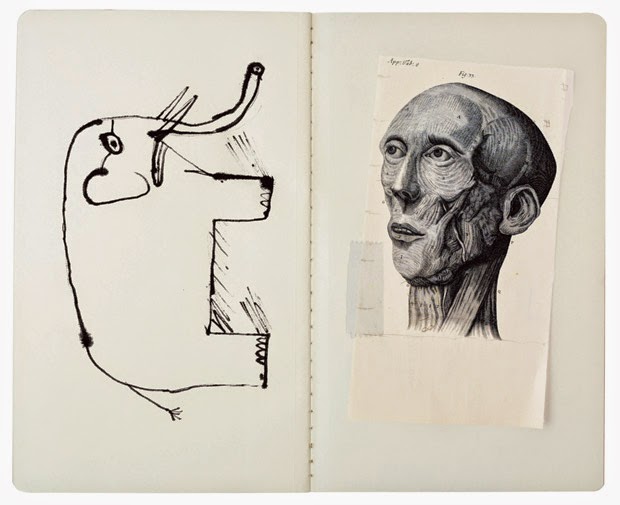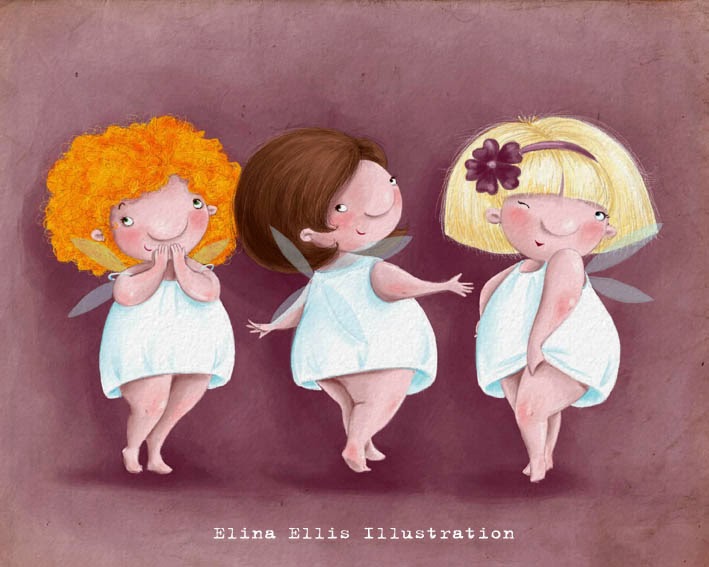A couple of weeks ago I have submitted my Project (which was another Picture Book, and I will tell you all about it a bit later) and an essay to my College. We have finished the third semester and I am half way through my education. Bigger half, in fact. Now I have only two semesters to go and I am on to my Diploma project.
So, the essay that I have submitted was about sketchbooks. I decided to share it with you. Who knows, may be you will find it useful or inspirational…
“Ever
tried. Ever failed. No matter. Try Again. Fail again. Fail better.”
Samuel Beckett
One of the main concerns
of every artist and illustrator is finding a way to nurture their own
creativity. Experimentation,
exploration of materials, problem solving, imagination, and a willingness to make mistakes are
some of the best ways to foster
creativity and creative thinking. Using a sketchbook allows us to
practice all of the above on daily basis without a fear of failing, being
judged or misunderstood.
Before coming to this
course I have never used a sketchbook or a visual diary. I have never done observational drawing and
all my ideas lived purely in my head. When an idea came to fruition I just sat
and drew a final piece. I have been introduced to keeping a sketchbook only a
year ago and my world, the way I think, and draw changed dramatically. My sketchbook is the single most valuable and
inspiring acquirement in my professional development as an illustrator. This is
the reason why I chose this topic for discussion.
When
it comes to using sketchbooks, I am in great company. Leonardo Da Vinci wrote
in his notebooks daily, finishing with around 13000 pages of work. His
sketchbooks are filled with drawings, diagrams and written notes of things he saw
and ideas he came up with. Picasso produced 178 sketchbooks in his life time.
He often used his sketchbooks to explore themes and make compositional studies
until he found the right idea and subject for a larger painting on canvas. Henry
Moore, filled one of his sketchbooks with drawings of sheep that often wandered
by the window outside his studio.
Henry Moore
There are a few good
reasons why sketchbooks and visual diaries are among the most precious
possessions of any creative person.
Any creative person can utilize sketchbooks as the
storage vessel whereby thoughts, observations and ideas are deposited in one
place, transforming a sketchbook into a versatile reference tool. Inspiration
strikes at the oddest moments and we need to honor it and note it down. It is then
possible to develop these ideas on the subsequent pages, and we will have that
entire creative process always available to us whenever we want to look back on
it. If we sketched out every single thought that popped into our heads, the
sketchbook would become a unique collection of key words, illustrations and
concepts.
Spanish
book cover designer Pep Carrió sees
his notebook as creative lab: “ For me, a
sketchbook is like a kind of a portable laboratory, a space to mark with
references, to capture the immediate, to experiment; a memory warehouse to
which I can return whenever I am searching for an idea or when I simply want to
remember an instant, a time in the past.” For London-based Japanese
illustrator Fumie
Kamijo, the sketchbook is a physical filing cabinet
for the lived experience that feeds
creativity: “Everything I have experienced goes into
my sketchbooks, the things I have seen, eaten, heard, felt, and, perhaps most
importantly, they are the perfect place to document my strange daydreams”.

Whereas Maurice Sendak
refers to his sketchbooks as foundation for his later work: “During
my early teens, I spent a lot of time at the window, sketching the kids at
play, and those sketchbooks are, in a sense, the foundation of much of my later
work. Maybe that’s another reason the children in my books are called
European-looking. Many of them resemble the kids I knew growing up in Brooklyn.
They were Jewish kids, and they may well look like little greenhorns just off
the boat. They had—some of them, anyway—a kind of bowed look, as if the burdens
of the world were on their shoulders.”
Sketchbooks provide a safe place for exploration and
experimentation. Sketches do not have to be pretty, beautiful, or even
immediately understandable by others. Sketchbooks are a place where we can play and be
completely free to mess things up and make mistakes. It's a perfect tool for us
to learn how to loosen up. We can try out things that we never tried before and
explore techniques and styles radically different from what we usually do. As
Paul Madonna said: “I
don’t think of sketchbooks as sacred…. They are rough materials. And in that is
where I find beauty. My notebook is with me always, always, always. It is an
extension of my mind. … I let my mind wander and pay attention to where it
goes. This is, in art, how I practice creativity.”
Paul
Madonna
Although
I draw digitally every day and illustrating is my profession, I am very
uncomfortable with drawing on paper. Being a perfectionist, I am concerned with
ruining my art or making a mistake, which freezes my creativity. Sketchbooks allowed
me to relax and get comfortable with making marks on paper. And I discovered that the best ideas come to
me when they are not forced and I am not under pressure to create something
decent or worthy. I just doodle and magic happens. But it is a very intimate
process. Sketchbook is my private place to escape and be free. I fully agree
with Bill Brown, who said: “My sketchbook is the opposite of my job.
It’s like a pocket-sized vacation. … No one knows I keep these books; it’s a
dirty secret. When I draw, I wander off alone. When people are around, I always
put the book away”.
The Sketchbook of Oliver Jeffers and Friends
Also, I think that sketchbooks
are a great opportunity to have some creative fun and get social with fellow
artists and illustrators. For example, in 2004, my favourite illustrator Oliver
Jeffers, took part in a project, where he had to
exchange a sketchbook with 3 other artists and follow one another's lead with a
weekly illustration. Over the course of 36 weeks, each would respond to the
previous artwork which proceeded them and then forward it onto the next in
line. Once completed, the sketchbook had travelled over 60,000 miles, and
crossed the Atlantic on numerous occasions. I still wonder who was the lucky
person who got to keep this wonderful sketchbook in the end?
Separate spreads from The Sketchbook of Oliver
Jeffers and Friends
One
more significant benefit of keeping a sketchbook is the fact that it gives me a
chance to have a chronological view of my progress. This is very important in times when I feel
like my art isn't as good as I want it to be, and I doubt my abilities. Seeing my
old art and witnessing that I am in fact improving can give a boost to get out
of this rut. So now I flip through my sketchbook pages for a while and see
solid proof that I am getting better all the time.
I think that real progress in
developing myself as an illustrator depends on me frequently and habitually
sketching out my ideas and their variations, reflecting on my ideas, and then
developing those that seem promising. I use my sketchbook to help me develop
this habit. As Neil Waldman once said: “Sketchbooks and journals are the street
lamps that illuminate the artist's journey.”
Sketchbook
encourages us to challenge our imagination. It enables us to see the world in
fuller detail so that when we finally capture the perfect element for our
sketchbook, we can express it better in our medium. In fact, after carrying a
sketchbook around for a few months, I have noticed how much clearer ideas
become when you are finally ready to work. Keeping a sketchbook can make you a
better illustrator and a better thinker.
Shaun Tan, The Bird King: An Artist's Notebook
The sketchbook is a
playground for my creative vision and it's a more important and effective
professional tool than I have ever imagined. Now my sketchbook is always with
me and the next time that silly imaginative idea pops into my head, no matter
how insignificant, I will scribble it down anyway. Not all doodles are intended
to be works of art, but every once in a while, one becomes a masterpiece.
Bibliography
Richard Brereton, 2012, Sketchbooks:
The Hidden Art of Designers, Illustrators & Creatives, Laurence King
Jane Stobart,
2011, Extraordinary Sketchbooks: Inspiring Examples from
Artists, Designers, Students and Enthusiasts, A & C Black Publishers Ltd
Danny Gregory,
2009, An Illustrated Life: Drawing Inspiration from the
Private Sketchbooks of Artists, Illustrators and Designers, F+W
Lynne Perrella,
2007, Artists' Journal and Sketchbooks: Exploring and
Creating Personal Pages, Rockport
Publishers Inc
Martin Salisbury, Morag Styles, 2012, Children’s Books: The Art of Visual Story
Telling, Laurence Ling
Shaun Tan, 2011, The Bird King: An Artist's
Notebook, Templar Publishing
The
Outrageous Comics of Paul Madonna
Maurice Sendak and the
Soul of the Artist




















